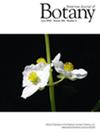Rare species do not disproportionately contribute to phylogenetic diversity in a subalpine plant community
Abstract
Premise
Within plant communities, few species are abundant, and most are locally rare. Worldwide, 36% of plant species are exceedingly rare and often face high extinction risk. However, the community phylogenetic impact of the loss of rare plants is largely unknown in many systems. We address this gap by investigating how rare species contribute to phylogenetic diversity, considering multiple metrics of rarity and multiple elevations in a subalpine plant community.
Methods
We collected abundance data at three sites near the Rocky Mountain Biological Laboratory (Colorado, USA). We calculated each species' range size from public occurrence data. We calculated phylogenetic signal for abundance and range size, compared community phylogenetic metrics weighted by range size and abundance to unweighted metrics, and quantified the change in phylogenetic diversity when removing single species and groups of species ranked by rarity.
Results
We found phylogenetic signal for abundance, but not range size. There was no difference between rarity-weighted and -unweighted phylogenetic diversity metrics. Finally, phylogenetic diversity did not decline more when we removed single rare species or groups of rare species than when we removed single common species and groups of common species.
Conclusions
We found that rare species, whether at low abundance or with a small range, do not disproportionately contribute to phylogenetic diversity in our subalpine plant community. These results were consistent across elevations. Instead, rare species might provide phylogenetic redundancy with common species. Deeper understanding of functional differentiation is needed to understand contributions of rare species to this system.





 求助内容:
求助内容: 应助结果提醒方式:
应助结果提醒方式:


